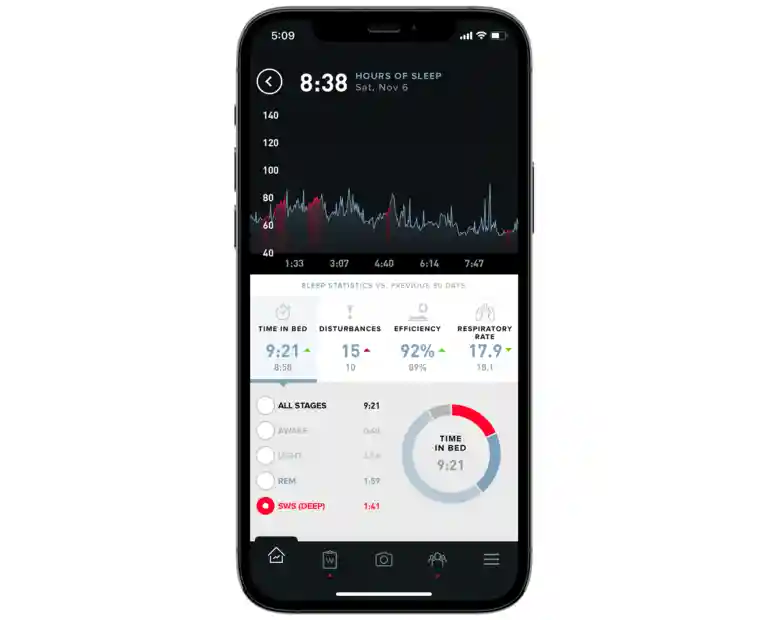Topics
- Article
- Health & Wellness
- Organizations
A Physician on How He Uses WHOOP & Recommends It to Others

Dr. Alex Hajduczok, a first-year Cardiology Fellow and avid CrossFitter, discusses the value he gets from wearing WHOOP and what others have to gain from monitoring and understanding their physiological metrics.
A few common questions I often get regarding WHOOP are “How do you use WHOOP?”, “Why should I get on board with WHOOP?”, or “How can WHOOP help me?" The answer, per usual, is “It depends.” It depends on many factors regarding how I personally use WHOOP and how the individual in question may want to use WHOOP. Let me break down how I usually approach this conversation.
How Can YOU Use WHOOP?
I usually start with some general questions:
- Would you be using it for sports training, general fitness, or basic health and lifestyle? (see the decision tree below)
- How are you sleeping? Do you think you could sleep more or “better”?
- How is your overall time management, could this be improved?
- Do you like data? Does simply having more information on things like sleep, and other physiologic metrics, appeal to you?
Regardless of your answers to these questions, one of the (many) really cool things about WHOOP is that it calibrates to you and is therefore hyper-personalized, so you can have just about any goal or use case in mind and still find value in the same metrics elite athletes and some of the world’s top performers do.

Dr. Hajduczok's decision tree for various ways a person might want to use WHOOP.
My Experience with WHOOP
I’ve been a WHOOP member since 2017 and I absolutely love the insights it provides. When I first began using the device, I was focused on helping my local CrossFit gym – Flower City CrossFit – qualify for Regionals in 2018 (which we did). With WHOOP I hit two-a-days and yet still balance my recovery (a measure of how prepared your body is to perform each day) to my strain (the cardiovascular exertion your body takes on). This allowed me to prevent over-training and also help me focus on enhancing recovery techniques (stretching, mobility, etc) when I was “in the red.” I was in medical school at the time, and therefore I was also trying to prioritize sleep. In fact, after the first few months of using WHOOP, I realized how poorly I was sleeping. This realization really helped me focus on improving my sleep hygiene, something that I’m still working on today.

WHOOP Enables Dr. Hajduczok to monitor strain from workouts and other daily activities.
Fortunately, having that data in real-time allows for constant adjustments and therefore minor improvements. Our daily lives are not always as structured as we like and WHOOP helps monitor on-the-fly adjustments to things like switching between working days and nights at the hospital, changing time zones due to travel, and other major changes in life (for example, moving to a new location, starting a new job, or adding a new family member to your life). The general goal is that small sustainable adjustments allow for long-term success. Some call this the 1% rule (making yourself 1% better each day has a profound compounding impact in the long run).
Sleep
Sleep is critical to recovery. Too many of us neglect sleep and try to perform our daily tasks after spending far less time than we should in bed the night before. This may work for a short period of time, but over time will catch up to us in the form of fatigue, burnout, and even illness and injury. Not to mention the negative impact on exercise performance. WHOOP provides unparalleled sleep performance metrics. Without the sleep data, and specifically the amount of REM/deep sleep and the sleep/wake times to aid with sleep consistency, I wouldn’t be able to balance a busy work schedule with a regular gym schedule. Sleep consistency is particularly critical because of its effects on circadian rhythm, sleep cycles, and maximizing restorative sleep (which is critical for physical and mental recovery). Visualization of time in bed is critical in instituting changes in sleep habits that have likely been in place for the last 10-20+ years.

Bed and wake times displayed in the WHOOP app give you a better understanding of sleep consistency.
The ability to look at things like time in bed versus time actually asleep, time spent in REM or deep sleep (together these are the restorative sleep stages, i.e. where recovery happens) versus light sleep, sleep disturbance, and sleep latency (how long it takes you to fall asleep) allow you to fine tune your sleep habits to optimize sleep based on your needs and limitations. Being able to look at your heart rate throughout the night is also very unique and valuable.

THE WHOOP APP provides a BREAKDOWN of THE TIME YOU SPEND IN EACH STAGE OF SLEEP.
WHOOP Journal
I also love the journal feature that WHOOP has. Seeing how all my habits and lifestyle decisions directly impact my physiology (HRV, sleep, etc) allows for a great feedback loop to make measurable changes. What is amazing about this feature is that it contains over 110 behaviors and lifestyle factors that you can log to see how they affect your data (i.e. caffeine use, hydration status, feeling stressed, post on-call shift, massage therapy, etc).
HRV
Heart rate variability (HRV)--what is it? Simply put, it is the beat-to-beat variation of your heart rate (using medical terminology, the variability in your R-R intervals). Overall, if your HRV is low, your body is actively recovering (possibly from high-intensity training or other lifestyle decisions, including stress). Conversely, a high HRV suggests that your body is primed and ready to take on another stimulus, and you are well recovered and ready to go. This can be applied to training (when you hit a double session or plan a rest day), or can be used to measure general trends over time (a steady increase would mean a progressive improvement in level of fitness). WHOOP allows for very close monitoring of physiology, but at the same time it also allows you to look at the overall adaptive changes. The big picture is visualized nicely with the weekly (WPA) and monthly performance assessments (where you can see your monthly trends over a full year).
Data Insights
I first realized how my training strategies changed over the years by looking back at 2+ years of HRV data and found what periods I made the most progress (then had to figure out why that was). Interestingly, some of the busiest times during residency were the months with the highest HRV because I was laser-focused in the diet and exercise arenas. Having this feedback was crucial, as it allowed me to refocus my habits and training to optimize things moving forward.

The MPA provides you with long-term trend analysis of HRV and RHR.
I was even able to fit in marathon training last spring amongst a tight work schedule and the CrossFit Open, Quarterfinals, and Occupational Games. As the training runs became longer and longer, it was like playing Tetris with deciding which days the long runs would be best suited for–I aimed for green recovery days for running, and CrossFit on all the rest (with some key rest days). Similarly, in the past I’ve found that even with recurrent high strain it is still possible to achieve optimal recovery. In March-April 2020, during a stretch of doing the workout ‘Murph’ every day for 30 days straight, I only had one red recovery. It is amazing how the body can adapt to rigorous training.
Other Health Metrics
Lastly, as someone who has always been fascinated by the cardiovascular system (currently in cardiology training), the fact that HRV is a huge factor in the WHOOP recovery score has been a major interest of mine. It’s led to me taking a deep dive into what else the WHOOP-measured physiological metrics can be used for. The simplicity of a wrist-worn device to measure parameters such as resting heart rate, sleep, and respiratory rate in addition to HRV make WHOOP an excellent data collection tool. We have several ongoing projects focused on improving medical training for residents, and improving patient outcomes in chronic diseases such as heart failure and inflammatory bowel disease. It is all very exciting stuff, and we hope to share results with the medical community upon conclusion of the studies. So, whether you are a high-level athlete, general fitness enthusiast, someone who is finding their way back into the exercise realm, or a research nerd like me–having access to the data WHOOP provides and understanding how to action it can help you achieve your goals. LEARN MORE: A Doctor's Heart Rate While Saving a Life & Combating Stress in the Intensive Care Unit Author Disclosure: Dr. Hajduczok declares that he has no conflicts of interest in writing this post. The products and services of WHOOP are not medical devices, are not intended to diagnose COVID-19, the flu or any other disease, and should not be used as a substitute for professional medical advice, diagnosis or treatment. All content available through the products and services of WHOOP is for general informational purposes only.